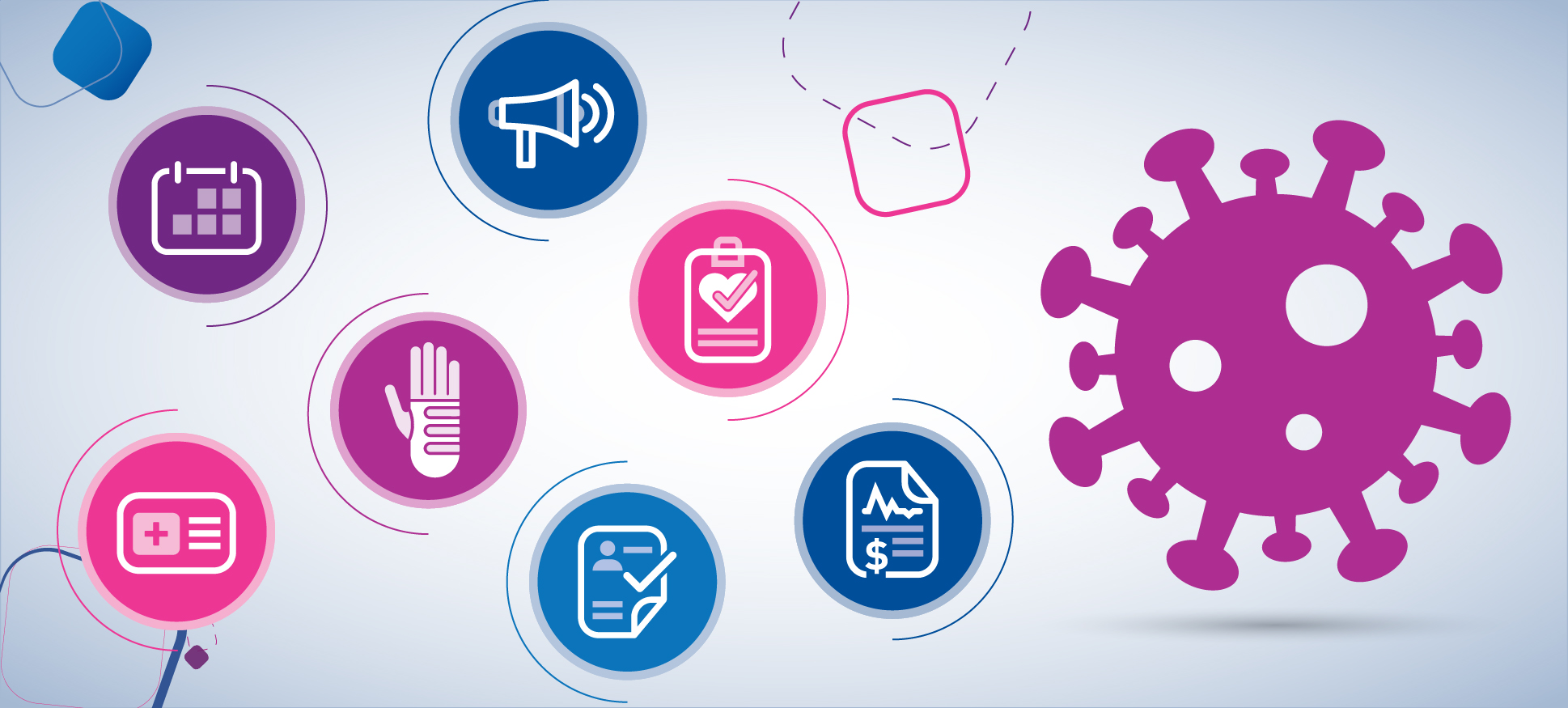Tag: patient experience

According to the most recent figures from the Centers for Disease Control and Prevention, around 8.8% of Americans are without health insurance. While this has dipped since the pandemic high of 10.3% towards the end of 2020, it still leaves nearly 30 million people facing the often-difficult decision of what to do when they need healthcare. A further 40 million underinsured individuals could find themselves in the same position. Do they pay for it themselves, avoid care altogether or seek financial assistance? With inflation on the rise and government pandemic support coming to an end, even those with coverage may need additional charity care support. Several regulatory efforts have been made to address healthcare affordability and increase transparency around charity care, particularly at the state level. For providers, the challenge is to find efficient ways to screen for charity care eligibility as more patients become eligible for support, and remain compliant as these new regulations come into effect. Why screen for presumptive charity? Eligibility for charity care depends on a hospital's financial assistance policy and relevant state regulations. Uninsured patients may be offered a full or partial discount on their medical bill, while insured patients may be awarded a discount on the cost of care. Without charity care, these unpaid bills would be tagged as bad debt, which could lead to patients being chased for payments they're unable to make and affect the provider's cash flow. To qualify for charity care, patients are often asked to share their household size and income, among other details. Often, a provider will ask patients if they'd like to fill out financial assistance forms during patient intake, but many patients decline or are unable to provide the necessary information. Some may feel embarrassed about needing support or worry about how the information will be used. There may be language or literacy barriers. Some may assume they're not entitled to support and decline the forms. To get around this, providers use automated screening software to identify patients who may be eligible for charity care. This pulls together credit information, demographic data and financial details to determine whether the patient qualifies. Patients get the support – and thus the care – they need, and providers can focus their collections efforts on those who are most likely to be able to pay. Regulation 501(r) permits this type of presumptive screening by a reputable third party. What does the legislation say about charity care? As the use of presumptive eligibility screening has grown, several federal and state regulations have been introduced to encourage clarity, consistency and best practice. Providers must keep pace with changes to charity care policy or risk civil penalties or the loss of tax-exempt status. Under the Affordable Care Act, Regulation 501(r) requires hospitals that offer charity care to have a written financial assistance policy, specify maximum amounts that eligible patients can be charged, and determine a patient's eligibility before sending their bill to collections. Again, it allows for this process to be automated using a third-party vendor. Individual states also have their own requirements around eligibility screening, for example: In Washington, the legislature has recently voted to expand charity care eligibility as of July 1 2022 for patients who meet federal poverty level thresholds and have exhausted third-party coverage options. The new rules require hospitals to identify patients that might be eligible for retroactive Medicaid support and support them in applying for coverage. In California, the AB 1020 rule raises the income level for charity care eligibility to 400% of the federal poverty level. Hospitals must display online notices explaining their policy for financially qualified and self-pay patients. They must also wait 180 days before assigning unpaid patient bills to collections, and provide information to patients before doing so. AB 532 requires hospitals to give patients written details of patient charity care and discount policies at the time of service or at least before they are discharged. How can providers streamline the presumptive screening process? Automated presumptive screening can help providers comply with these new rules and implement their own financial assistance policies in the most efficient way. For example, Experian Health's Patient Financial Clearance uses current financial data to screen patients for Medicaid, charity care and other financial assistance programs in line with the provider's unique charity policies. It incorporates customizable logic that helps providers adhere to regulatory requirements and internal rules around charity care and billing. Screening happens automatically prior to or at the point of service, generating an estimated Federal Poverty Level (FPL) percentage for each guarantor. A healthcare-based propensity to pay score can also be calculated, giving providers a further data point to work best with patients. This makes it easy for patient advocates to connect patients with the most appropriate financial assistance program, and even auto-enroll them. If the patient does have an amount to pay, they can be guided to the optimal payment plan for their individual circumstances. Patients can get direct access to screening qualification tools too, with solutions like Patient Financial Clearance. They can check their qualification status and upload documentation to qualify for discounted or free care via text to their mobile device. In addition to helping providers ensure regulatory compliance and document charitable services, this tool helps maximize collections and deliver a patient-centered financial experience. Providers should also check that their collections partners are aware of their obligations under charity care law, and ensure they're compliant, too. Keeping patients in the loop during charity care eligibility screening Clear communication is at the heart of a compassionate patient experience, fostering loyalty and trust. In the context of charity care screening, this means making sure that patients know that financial assistance may be available (now also a requirement under charity care regulations). In the past, some patients were not informed about how to apply for financial assistance and struggled with bills they couldn't afford. Others were assigned to charity care without their knowledge and spent months worrying unnecessarily about bills that would never arrive. Automated charity care checks solve both situations, by ensuring that no patient misses out on support to which they're entitled and by making it easy for providers to notify them. Patient Financial Clearance generates scripts for patient advocates to use during financial counseling discussions, to help patients navigate the financial process with greater ease. And with mobile text charity screening, the patient gets the information they need, right in the palm of their hand, so they can engage with the process more easily. Patient Outreach solutions can complement these activities by providing timely and personalized prompts and reminders through the patients' preferred communication channels. Not only will this enhance the patient experience and support compliance with charity screening rules, but it also helps improve patient outcomes by keeping patients on track with their care plans and driving down unnecessary readmissions. And for patients who do have an amount to pay, a payment experience that's tailored to their financial circumstances will further boost patient satisfaction and collections. The ROI on these tools can be significant. Let's say a hospital treats 1,460 uninsured patients per month. If just 10% of those patients qualify for Medicaid, at an average reimbursement rate of $1000, the hospital could claim $146,000 per month by ensuring those patients are enrolled – and avoid writing off nearly $1.8 million per year. As economic uncertainty continues to weigh on providers and patients alike, the pressure is on to streamline patient collections and prevent avoidable missteps such as non-compliance with charity care rules. Find out how using an automated financial assistance process with Patient Financial Clearance can create a safety net for providers and patients, increase collections and reduce bad debt as patient financial responsibility increases.

Healthcare staffing shortages are patients' biggest safety concern, according to a new study by ECRI. Pandemic pressures led many healthcare workers – clinical and non-clinical – to join the “Great Resignation,” causing a significant drop in hospital employment since February 2020. Insufficient staffing can lead to longer wait times and clinical and administrative errors, which can present a real threat to patient safety. Critical shortages also erode financial performance through wage inflation, recruitment and training costs, and hampered productivity. As the problem persists, providers are seeking effective solutions to alleviate the burden on their existing workforce and solve for healthcare staffing shortages. Digital tools and automation should be top of the list to help improve efficiency, increase staff satisfaction, and corral the resources needed to deliver high-quality care in a cost-effective way for non-clinical jobs. Creating the conditions for a thriving healthcare workforce The pandemic exacerbated longstanding issues with understaffing and burnout that led to healthcare staffing shortages, but it also expedited several digital innovations that may be part of the solution. An aging population coupled with increasing public health concerns aren't going to make the situation any easier, so healthcare leaders should leverage these digital advances to build a resilient workforce. For non-clinical roles, advanced data analytics and automation can complement wider workforce strategies – by making it easier for downsized teams to do more with less. This can help reduce time-consuming manual work, eliminate frustrating and unnecessary rework, and streamline workflows to increase efficiency and job satisfaction. By handing off repetitive and rule-based tasks to intelligent software, administrative and billing teams will be able to manage the growing workload with less staff and focus their efforts on the tasks that really need a human touch. How digital tools can fill in the gaps created by healthcare staffing shortages 1. Streamline non-clinical workflows with advanced analytics Analytics can capture organization-wide insights to inform planning and optimize staff resources on a day-to-day basis. By taking a deep dive into existing processes, providers can better understand what tasks are really necessary. Eliminating superfluous activities and automating those that don't need a human touch means that available staff can be deployed more efficiently. This is more than simply digitizing existing workflows. The real power lies in combining updated technology with strategic process improvements. For example, automated patient outreach allows providers to send automated messages and appointment and bill reminders to patients, so fewer staff members are needed to manage calls. It can also be used alongside consumer data to segment patients according to their needs, so providers can identify and reach out to those that may need to reschedule care. This can help forecast future demand with greater accuracy. 2. Facilitate self-service patient access with automation Equipping patients with the digital tools to complete more administrative tasks themselves is another effective way to reduce the need for staff input. Self-service patient scheduling and registration solutions give patients the convenience and choice they desire (as revealed in Experian Health's State of Patient Access survey 2.0). They also minimize the manual tasks and call volumes that put pressure on understaffed patient access teams. Digital scheduling also plays a role in patient care. Online scheduling reduces the risk of no-shows because it's easy for patients to book and reschedule appointments at a time they know they can attend, thus avoiding diagnostic and treatment delays that could lead to poorer health outcomes. And unlike manual registration processes, data errors are far less likely, which helps avoid delays and rework later. Automated self-scheduling and registration platforms allow small teams to handle more complex work, which improves staff satisfaction and increases the likelihood of positive patient outcomes. 3. Let better data minimize staff time spent on revenue cycle tasks Understaffed teams must allocate their time carefully. Significant amounts of staff time can be saved throughout the revenue cycle with more accurate and timely data. For example, Kootenai Health in Idaho saved 60 hours of staff time in two months by automating patient financial clearance. More patients were assigned to the correct financial pathway, and reliable data insights helped reduce manual work and guesswork, leading to fewer bills being written off. A particular challenge for busy teams is managing frequent changes to prior authorization requirements. Prior authorization software pulls information from multiple health plan websites to give staff real-time visibility into current requirements and generates an exception-based workflow so they can focus on high-priority tasks. Ease workforce pressures and enhance the patient experience with automation Automation is not a substitute for the care and attention provided by expert healthcare workers. However, new digital and data-driven technologies can complement person-to-person interactions and ease pressure on busy teams. Integrating reliable data sources, analytics and responsive workflows can help providers manage current shortages and future workforce challenges by removing unnecessary manual tasks, reducing errors, and offering insights to improve patient-facing and back-office systems. Contact us to find out how Experian Health's data-driven insights and automation can help solve for healthcare staffing shortages, protect the revenue cycle and maintain high-quality standards of care.

Healthcare’s digital transformation promises patients ever-growing choices in how to access, experience and pay for care. Providers know that opening their digital front door is the key to attracting and retaining loyal consumers. However, deciding on the exact technologies and services to offer can be challenging. A good place to start is to follow the patients’ lead: what digital tools do they say they want? How are they using existing services (or not)? By understanding patients’ attitudes and behaviors, providers can design a digital patient journey that leads to increased patient satisfaction. A new collaborative report by Experian Health and PYMNTS provides fresh insights to inform digital patient engagement strategies. This survey, conducted in January 2022, interviewed over 2000 patients to understand how they’re using digital methods to access healthcare services and their biggest pain points. The findings revealed a need for digital services that foster convenience and choice. Digital-savvy consumers expect user-friendly online options across the care continuum, from scheduling and registration to final payment. Improving these services is also likely to encourage the less digitally confident consumers to try alternative methods and increase access to care. This article offers a snapshot of the key findings that will help providers identify gaps in their digital offerings and build a digital experience that meets consumer expectations. Finding 1: Patients are looking for digital methods to perform most healthcare activities. Patient portals are the most popular method for obtaining test results, with 44% of patients choosing this option. A quarter of patients have used digital methods to pay their medical bills. Digital methods are widely used across the patient journey, from scheduling appointments to receiving test results. Patients expect convenience, flexibility and choices, with many reporting frustrations when they can’t access the digital services they desire. Providers that offer a broad selection of digital patient engagement solutions will be best placed to respond to changing consumer demands. Beyond patient satisfaction, digital tools facilitate better care plan adherence, improve workforce efficiency, and contribute to higher patient collections rates. Finding 2: Patients are satisfied with their healthcare experience but find it challenging to confirm costs and select new providers. 15% of patients report difficulties when obtaining accurate cost estimates for appointments and procedures. Predictably, digital-first patients have the highest expectations of digital systems. They are accustomed to convenient and accessible digital processes elsewhere in the consumer world. Healthcare organizations with an open digital front door will be more attractive to these potential new patients. Digital payments could be a worthwhile investment in this regard. A previous PYMNTS survey found that 63% of patients would consider switching providers if the payment experience wasn’t up to par. To improve the payment experience, providers should consider offering upfront pricing estimates to make it easier for patients to understand and plan for their bills. A tool such as Patient Financial Advisor can act as an online financial concierge for patients, by connecting them with appropriate payment plans and contactless payment methods directly through their mobile devices. Finding 3: Two-thirds of patients use patient portals, but many find portals lack essential payment features. While 62% of patients use portals, this rises to 82% among digital-first consumers and drops to 19% among non-digital consumers. 64% of patients say cost estimates are very or extremely important, but only 24% say they receive estimates. Closing the gap between what patients expect of portals and what’s actually delivered could help narrow the differences in portal usage between different patient groups. Credit and debit cards are currently the most popular payment methods, but patients would use them less often if their preferred digital payment methods were available. Providers should consider combining high-performing patient portals with a range of payment options. Finding 4: Frictionless patient portals could prevent patients from switching providers. 61% of patients say they would switch to a healthcare provider that offers a patient portal. Improving patient portal capabilities is likely to be an important driver in attracting new patients. However, it’s also essential to retain existing patients. More than six in ten patients say they’d switch to a provider that offers a patient portal. This number rises to nearly eight in ten younger patients. A digital-first experience is no longer simply a preference, but an expectation for many consumers. To better engage and retain consumers throughout the patient journey, providers must explore the use of patient portals and other digital solutions to remove digital pain points and meet consumer expectations for a frictionless patient access experience. Download the full report to learn how healthcare providers can relieve digital pain points to offer improved patient care and satisfaction.

“The patient can have a wonderful clinical experience but face a financial experience that falls short of expectations. We wanted a dedicated consultant who would recommend best practices and provide valuable industry insights. We wanted a system with proven results in back-end automation, operational improvement and analytical performance. We were looking to propel our patient experience to the next level and that’s why we partnered with Experian Health.” – Director of Patient Finance at Novant Health Delivering remarkable patient experiences is at the heart of Novant Health’s organizational vision. With a growing consumer base – the North Carolina health system logged over 5.8 million medical encounters in 2020 – they turned to automated patient collections to ensure a better financial journey for their growing patient population. They also looked to automated workflows as a way to ease pressure on staff, who were managing 21 different collections agencies. The objective was to find a partner that could help to elevate agency performance while driving operational efficiency. With new facilities coming online, it was important to find a system that would integrate with Epic® and provide real-time reporting. Novant Health partnered with Experian Health to implement Collections Optimization Manager, which produces robust accounts receivable insights to determine each patient’s propensity to pay and scrub uncollectable accounts. The product also provides real-time reporting and agency scorecard, so providers like Novant Health can optimize their processes and forecast future performance. Predictive patient segmentation allows Novant Health to quickly identify the patients with the highest propensity to pay and prioritize accounts accordingly. Patients in need of financial assistance or charitable support can be directed to the right resources. Collections are faster, more efficient and more compassionate. With support from a designated Experian Health Collections Consultant, Novant Health can also monitor agency performance and keep agency costs in check. Improved patient segmentation, better allocation of staff resources and more efficient agency management has led to the following results: 8% increase in unit yield year-over-year 5% recovery rate a rolling average return on investment of 8.5:1. Discover how Collections Optimization Manager can help your organization improve collections recovery rates and deliver an improved patient financial experience.

As patient expectations shift, providers that offer a personalized healthcare marketing experience will be more likely to attract and retain satisfied consumers. The pandemic accelerated this shift. As a result, the traditional ways of healthcare marketing are starting to fall short. For example: A healthcare marketing strategy that’s designed for an “average consumer” results in a one-size-fits-all model that doesn’t always meet a patient’s individual needs. Communication options with fixed hours and channels don’t reflect “patient first.” Outreach messages blasted to an entire patient email list miss the mark for individuals who don’t speak the language or might prefer a quick text message instead. A study by Dassault Systèmes and CITE Research found that 83% of consumers expect products and services to be personalized within moments or hours. They’re accustomed to the “one-click” digital retail experience, which offers instant access to relevant recommendations and flexibility about how and when to buy. They’re also suffering from information overload, thanks to the sheer volume of emails, messages, articles and videos flooding their digital devices. Personalized communications can remedy that and help consumers feel respected and empowered, which drives connection and loyalty. But personalization isn’t just important for patient outreach. Personalized healthcare marketing can also help ensure patients get the treatment they need, by anticipating individual needs and highlighting relevant services at the right time. With the COVID-19 pandemic continuing to influence access to care, personalized healthcare communications can also be tailored for different patient segments. This can help reassure or remind individuals to book vaccination appointments or reschedule deferred care. Improve patient engagement with personalized outreach As digital offerings grow, consumer engagement expectations evolve. Providers must keep pace and communicate accordingly. Incorporating information about patients’ lifestyles, behaviors and preferences enables providers to deliver the right message at the right time. It also helps providers select and use the most effective channel of communication. Patients are more likely to respond and are empowered to manage their healthcare journey. For example, a Gen Z patient may prefer to receive appointment reminders by text, while an older patient may prefer a physical letter. One patient may prefer to get prescriptions mailed to their home while they’re at work, while another may be content to visit a pharmacy and pick up their medication while shopping nearby. Some patients will want a text message with a payment link to clear outstanding bills immediately, while others will appreciate a customized payment plan. Experian Health’s State of Patient Access survey 2.0 found that patients welcome proactive outreach by providers, though many say this doesn’t happen. Providers recognize the value in proactive patient engagement, but many say they lack the data to reach out effectively. With reliable consumer data and analytics, providers can create holistic profiles and deliver improved marketing to better serve new and existing patients. ConsumerViewSM pools data points on core demographics, behavioral insights, psychographic information and financial data to help providers understand their patients. This data can then be analyzed using Mosaic® USA and TrueTouchSM to segment, identify and reach the target audience with the most relevant message and format, and adapt based on consumer response. ConsumerView also adheres to consumer data privacy regulations, so providers can actively engage patients and build patient loyalty while confident in the knowledge that they have permission to use the data. Reduce readmissions and improve patient outcomes with better segmentation Personalized healthcare marketing isn’t just about messaging and channels. Providers that have a holistic picture of a patient’s lifestyle, life events, geographic changes and socio-economic challenges will be in a stronger position to anticipate their evolving wants and needs. For example, social determinants of health (SDOH) data can tell providers which patients may need extra assistance when visiting a doctor’s office, so that appropriate measures can be put in place. They might help identify patients with potential comorbidities that warrant proactive reminders about preventive check-ups. Similarly, providers can segment patients according to their financial situation. This can help with creating custom payment plans and sending timely payment reminders through targeted communications channels. Effective post-admission engagement can also help patients access the support needed to adhere to care plans, thus minimizing the risk of readmission and reducing unnecessary costs. A McKinsey & Co study found that around a third of patients with unplanned, high-cost follow-up care reported reasons that were considered avoidable, such as receiving unclear post-discharge instructions. Boost retention and recruitment with patient-centric and personalized healthcare marketing As rising medical costs and pandemic-related lifestyle shifts prompt more patients to shop around for care, providers must take action to create a healthcare experience that’s truly patient-centric. With data-driven healthcare marketing tools, providers can differentiate their services from other health systems vying for the same market. Find out how Experian Health can help your organization use consumer insights to build a patient-focused, personalized health marketing strategy to attract and retain satisfied consumers.

The recent discovery of the Omicron variant has placed the world on high alert. As COVID-19 continues to transform and evolve, erupting as “new” pandemics within the existing pandemic, it is becoming clear that digitally-enabled clinical care and access to that care are some of the world’s tools to mitigate its spread. Should infection rates rise, providers can anticipate fluctuations in patient volumes, which may trigger a return to the scheduling complexities seen earlier in the pandemic. Streamlining patient access with digital scheduling to minimize wait times, free up hospital beds, and ensure efficient intake workflows is going to be crucial. New variants could also exacerbate existing healthcare staffing shortages, which is a major concern for providers whose capacity is already at a “tipping point.” With a winter flu season “twindemic” looming on the horizon, and more people traveling over the holidays, this challenge may only get tougher. One route through this uncertainty is to continue the digital pivot seen in the early days of the pandemic. Here, we look at how flexible self-scheduling tools and other digital services can continue to help providers maintain operational efficiency as they navigate the implications of this new coronavirus strain. Uncertainty about Omicron – and future variants – could trigger patient scheduling complexities The new variant could trigger a rise in patient numbers, as seen with the Delta variant. In parallel, some providers and states may follow New York’s lead to try to manage non-urgent care and postpone certain elective treatments. Patients, too, may decide to hold off on booking appointments if they’re worried about contracting the virus while visiting their doctor. This means that the scheduling (and rescheduling) challenges seen throughout the pandemic could resurface. Providers should be ready to offer easy and convenient self-scheduling options. Digital patient scheduling platforms allow patients to book essential care and reschedule deferred appointments from the comfort of their own home, using whatever channel suits them best. Not only will this ease pressure on busy staff and reduce the number of people sitting side-by-side in doctors’ waiting rooms, but it’s also a quicker and more reliable way for patients to plan their care. Providers can augment these operational efficiencies with digital scheduling and registration tools. Registration Accelerator can reduce the burden on patient access teams by allowing patients to create user profiles and fill out pre-treatment information from home. Double down on convenient vaccination scheduling New variant outbreaks also add a layer of urgency and complexity to the ongoing vaccination program. Boosting the country’s vaccination rates is a crucial defense against existing strains of COVID-19. Patient-friendly digital scheduling tools can make it as easy as possible for people to arrange an appointment, thus helping to bump up vaccination rates. Of course, if more people are encouraged to seek vaccinations and boosters, the scheduling process could get even more complicated. Again, digital self-scheduling tools can ease the pressure, by using real-time databases and automation to ensure that patients book appointments within the requisite vaccination window. Automation can also be used to deliver personalized patient outreach reminders, nudging patients to schedule their vaccine appointment if they haven’t made one already. Comprehensive consumer data can help identify the most appropriate messages and channels for different patients, to make it as easy as possible for them to plan and book their appointment. The federal response to new outbreaks has included provisions for vaccine outreach campaigns and education initiatives. Providers should consider how their own outreach campaigns are performing, as well as ensure that their scheduling platforms are ready to meet the increase in demand that’s likely to follow. Automation and digital scheduling tools could help alleviate staffing shortages Behind the scenes, providers are still wrangling with ongoing staffing shortages. According to an analysis of US Bureau of Labor Statistics data, hospital employment declined by nearly 100,000 between February 2020 and September 2021, amounting to a financial cost of around $24 billion. New variants could make this worse. If more staff are infected, healthcare organizations may find it more difficult to handle the increase in patient volume. Automating manual tasks can free up capacity by helping to manage the growing demand for services and reduce call volumes. These automated tools and systems are designed to be user-friendly for busy staff, and for patients looking for a stress-free patient access experience. With streamlined self-scheduling options and more efficient staff workflows, providers can feel more prepared in the face of uncertainty. Contact Experian Health to find out more about how digital scheduling tools can help your organization prepare as the Omicron situation unfolds.

As the digital healthcare revolution takes hold, do assumptions about a generation gap still hold true? Do Millennials and Gen Z have different expectations of healthcare providers compared to Baby Boomers and Gen X? In today’s hyper-connected world, the differences are a matter of degree. We’re all Gen C now. Futurist Brian Solis coined the term “Gen C” in 2012 to describe the rise of the “connected consumer,” a generation of active participants in the digital-first economy. Recently, the term has come to be associated with everyone living through the age of COVID-19. This includes pandemic babies whose early months have been shaped by quarantines and virtual playdates, and consumers of all ages who have reimagined their lives through digital tools and services. Gen C transcends the usual generational divides. Experian Health’s State of Patient Access 2.0 survey shows that patients of all ages embraced self-service technology and virtual care during the pandemic. Younger groups may be in the majority, but demand for a consumer-centric digital patient experience crosses demographic lines. Forget Millennials and Gen Z – it’s Generation COVID that’s driving the healthcare revolution. In this article, we look at what healthcare providers need to know about the attitudes and expectations of Gen C consumers. How does healthcare need to adapt to successfully engage the connected generation? Gen C: it’s an attitude, not an age Think With Google describes Gen C as a “powerful new force in consumer culture… people who care deeply about creation, curation, connection, and community. It's not an age group; it's an attitude and mindset defined by key characteristics.” Understanding the Gen C mindset will give providers the competitive edge when it comes to patient engagement. What might that look like? Gen C is constantly connected. Nearly nine in ten have a social media profile, with two-thirds updating it daily. They’re accustomed to organizing their life through apps and digital technology. Younger Millennials and Gen Z have grown up with the digital world in the palm of their hand, and have come to expect quick, flexible, and convenient app-like access to real-life services. Gen C values authenticity and transparency. Recent political, economic, and environmental turbulence has created a group of consumers who choose brands and services according to their personal values. There is also a greater emphasis on convenience and price. Instant access to information means they may be more likely to question healthcare advice and compare services. And news reports of data breaches and corporate scandals mean providers may need to work harder to gain their trust. Gen C chooses brands that embrace the power of personalization and community. Gen C expects personalized patient experiences. However, they’re also looking for community. Health and wellness brands that facilitated connection through online groups grew in popularity during the pandemic, especially when people were unable to work out together. As influencer culture continues to evolve, more brands are inviting real consumers to act as brand advocates. This includes utilizing social media to give consumers an opportunity to engage directly in product development. Healthcare services that can offer ways for consumers to connect with like-minded communities will be particularly attractive to Gen C. How does Gen C feel about health? It’s no surprise that the pandemic has made consumers more health-conscious. Gen C takes a more holistic view of health than previous generations and is more likely to use wearables and fitness apps to track their health goals. They’re also more comfortable talking about previously taboo topics, such as mental health or sexual wellness. Digitally fluent consumers are also more comfortable seeking answers to health questions online. A study by Gartner found that 41% of consumers with a health issue would talk to friends or family, and 38% would search for information on their own, before contacting a physician. There’s an opportunity for providers to position themselves as the first and best resource for reliable, engaging and accessible health information. As Gen C’s influence grows, it pays for providers to invest in understanding their needs and expectations. How should providers adapt the healthcare experience for Gen C? Offer convenient, flexible and self-service access to care Flexibility, speed and convenience are woven into Gen C’s expectations of the healthcare experience. The State of Patient Access 2.0 survey found that around seven in ten consumers said they wanted to be able to schedule their own appointments online, and a similar number wanted the option to contact their provider through a patient portal. Gen C is less likely to use a desktop computer or make a phone call, so enabling mobile-friendly apps is key. Online self-scheduling allows patients to find and book available appointments using their mobile devices. Integrations with scheduling rules and up-to-the-minute calendar checks mean patients are only shown the most relevant provider booking information. It’s a closer match to their other consumer experiences, as opposed to long phone calls and wait times with a call center representative. Similarly, automated registration tools can simplify patient intake and give consumers the option to check their details on their mobile devices. Rather than filling out multiple paper forms that are labor-intensive and error-prone, patients can simply complete the process on their phone or tablet. And for the 39% of patients who worry they’ll catch an infection at their doctor’s office, being able to complete intake tasks without sharing clipboards and pens in the waiting room will be a huge relief. In a recent podcast interview with Beckers Hospital Review, Jason Considine, Chief Business Development Officer with Experian Health, said: “With COVID-19, digital tools and data-driven solutions introduced more streamlined processes into our healthcare system. The expectation is that they’ll remain. Providers must embrace this digital transformation. Invite patients to self-schedule online, leverage digital outreach tools, simplify the registration process, and provide a transparent cost of care with flexible payment options… We need to create a simple consumer experience that matches what patients have in other facets of their lives.” Use consumer data to offer personalized outreach and boost patient loyalty Understanding Gen C requires providers to rethink patient loyalty. In the past, patients might choose a physician and stick with them for much of their adult life. Now, they’re more likely to shop around. Research published just before the pandemic showed that 73% of consumers expect companies to understand their needs and expectations, and 62% expect those companies to adapt according to the consumer’s actions. Experian Health’s survey also showed that patients welcome proactive outreach by providers, though many providers fail to do so. Nearly half of providers said that inaccurate or incomplete data prevented this. Providers know that a personalized healthcare experience is good for their bottom line, but without reliable data about each patient’s needs, preferences, and lifestyle, delivering this is a challenge. Consumer healthcare marketing data can pull together reliable data sources to allow providers to communicate the right message in the right channel for different patient segments. For an even richer view of patients’ individual non-clinical needs, providers should consider including social determinants of health (SDOH) data. COVID-19 revealed gaps in healthcare providers’ capacity to leverage data to support economically and socially vulnerable groups. With this type of data, providers can personalize their outreach strategies in a way that truly supports individual patients and underserved communities. Make it easy to pay with upfront estimates, coverage clarity, and digital payment methodsHousehold financial concerns were felt even more acutely over the last two years. Younger generations say they’re more likely to consider cost when it comes to making healthcare decisions, with almost 60% saying it’s now the main consideration. Gen C expects upfront, transparent cost estimates, with two-thirds of younger consumers saying they’re more likely to seek out medical care if they know the cost beforehand. The State of Patient Access 2.0 survey confirms that price transparency remains high on the list of patient demands.To this end, there has been a major regulatory push toward price transparency at the federal and state levels. Many providers are deploying transparent pricing strategies and payment estimate tools to make it easier for patients to navigate the costs of care. Demonstrating a commitment to price transparency can be a powerful marketing strategy to attract and retain loyal consumers – especially for those who are most affected by fluctuating employment and financial circumstances. Watch our interview with Dan Wiens, Product Director for Patient Estimates at Experian Health, in which he describes how price transparency and patient estimates will evolve in 2022. Patient payment estimates give patients clear, accessible, and easy-to-understand estimates before they come in for care. A cost breakdown is delivered straight to their mobile device, with the option to pay right away. In addition to payment estimates, Gen C is looking for payment plans and payment mechanisms to be available at their fingertips, anytime, anywhere. In a world where they can order food and pay household bills at the tap of a button, it can be frustrating to have to wait a month for a medical bill. In fact, 70% of consumers say healthcare is the industry that makes it hardest to pay. Providers that can offer a choice of simple payment methods, pre-and post-service, will be likely to attract more Gen C patients. An integrated solution such as Patient Financial Advisor can help these tech-savvy consumers see their estimated cost of care, and make payments right from their mobile device. For providers, the benefits of making it easier for patients to pay are clear. As demand for transparent and contactless payment methods continues to grow, investing in these digital innovations could be an effective route to recouping some of the financial shortfall experienced during the pandemic. Don’t forget – more healthcare staff are Gen C, too Digital transformation isn’t just a consumer issue. Many of the digital tools and services that enable providers to meet the needs of connected consumers will offer benefits at the organizational level too. Automation and advanced analytics lead to more efficient processes, better use of staff resources, fewer errors and more meaningful workflow insights. Time and money are saved, profits increase and staff enjoy a more satisfying working experience. Investing in incremental innovations on back-end systems is even more relevant, given that growing numbers of healthcare staff are Gen C themselves. Just like consumers, they are accustomed to using digital apps and tools to run their lives, and they’re looking for similar efficiencies while at work. Failure to provide staff with the tools they need to do their jobs in the digital age could lead to wasted time, revenue loss, and the adoption of less reliable and secure workarounds. With the right digital tools and systems, providers can equip staff to fulfill their roles safely and effectively -- attracting and retaining a high-performing workforce. Providers must open their digital front door to secure patient loyalty now and in the future The pandemic has cemented a cultural and practical shift in the way healthcare is delivered. Now that more patients have had a taste of a digital patient experience, they expect it to continue. Gen C is pushing the healthcare industry to catch up to convenient, connected, consumer-centric services that are the norm elsewhere. Providers that can engage with Gen C in their digital language now will attract more satisfied consumers over the long term. Contact us to find out how we can support your organization bring together all the digital tools at your disposal, to create a healthcare experience that’s in line with Gen C’s evolving expectations.

Being able to settle bills anytime, anywhere, is one of the reasons why 110 million Americans switched to “digital-first” payment methods last year. Today’s consumers can pay household bills with their mobile devices while cooking dinner or waiting in the school pick-up line. They can pay for their morning coffee by tapping their phone at the point of sale. Imagine their frustration when paying for healthcare still involves paper bills, multiple phone calls, and limited payment options. But the healthcare industry can make the same “anytime, anywhere” payment promise. Berenice Navarrete, Director of Product Management for Patient Payments at Experian Health, says: “We’ve seen healthcare make great strides in using automation and digital tools for scheduling, registration, and telehealth, fueled in no small part by the pandemic. As consumer payments are constantly evolving, there are huge opportunities for improvements in the patient payment experience too.” “We’ve seen healthcare make great strides in using automation and digital tools for scheduling, registration, and telehealth, fueled in no small part by the pandemic. As consumer payments are constantly evolving, there are huge opportunities for improvements in the patient payment experience too.” -Berenice Navarrete, Director of Product Management for Patient Payments Experian Health’s recent Payments Predictions white paper identifies seven emerging healthcare payment predictions and trends heading into 2022. This blog offers a preview of the top three insights that will be of interest to providers intending to leverage – or considering – digital tools that simplify payments and speed up healthcare collections. Prediction: Patients want fast, secure and smooth payments to match their experience in other industries. According to Experian Health’s State of Patient Access 2.0 survey, providers are feeling more confident about collecting payments from patients now, compared to a year ago. However, the collections landscape is always changing; providers should continue to find ways to match consumer expectations with tailored communications, flexible payment options and automated payment methods. Listen in as Matt Baltzer, Senior Director of Product Management at Experian Health, explains why providers feel more confident about patient collections. He also discusses how automated healthcare solutions can help providers shore up these gains and optimize healthcare collections – especially as consumer behavior returns to pre-pandemic patterns. As cash usage declines, patients are looking for a wider variety of payment options – a trend that’s likely to gather steam as digital payment platforms like Apple Pay and Google Pay continue to gain traction. Providers must keep pace with these advances in consumer payment technology. Utilizing Patient Financial Advisor is one way to give patients the flexible experience they want. This solution sends personalized text messages with links to convenient and contactless ways to pay. Patients may have different preferences about payment methods, but they all want to feel confident that their payment is secure. With PaymentSafe, healthcare providers can collect any form of payment securely and quickly, regardless of the payment option a patient chooses. Prediction: Patient loyalty will be tied to a convenient and compassionate payment experience. A poor payment experience will leave a bad taste in the patient’s mouth, regardless of how good the rest of their healthcare journey has been. With 70% of consumers saying healthcare is the industry that makes it hardest to pay, any provider that offers a smooth, supportive and transparent payment experience is going to stand out from the competition and foster greater patient loyalty. Comprehensive consumer data can give providers early and accurate insights into a patient’s specific financial situation. This information can help providers direct the patient to the most appropriate financing options. Automation can then be leveraged to send timely reminders of open balances, improve patient engagement and minimize the risk of missed payments. Tools such as Patient Financial Advisor and Patient Payment Estimates can help providers give patients transparency, control and reassurance from the very start of their financial journey, so bills are settled quickly and easily. Prediction: Automation will be used for an increasing number of payment-related tasks. Artificial intelligence and automation aren’t just for cars and the metaverse. Technological advancements are opening up a wide range of benefits to healthcare providers, from faster patient payments to fraud prevention. Automation also enables operational efficiencies in reporting and reconciliation, while protecting and processing unprecedented amounts of patient data. For example, Collections Optimization Manager uses extensive datasets and advanced analytics to segment patient accounts according to each individual’s specific financial situation. Patient satisfaction will improve because patients receive the right support at the right time. Additionally, providers will be able to use monitoring and benchmarking data to spot previously unseen opportunities and further improve collections. Keeping that “anytime, anywhere” promise COVID-19 was a catalyst for the evolution of healthcare payments. Digital payment solutions that give patients easy, convenient, and safe ways to pay not only help meet changing consumer expectations but will also allow providers to boost loyalty and revenue for years to come. Download the white paper to discover a full list of healthcare payment predictions and find out how to create a modern payment experience that meets patient expectations.

COVID-19 transformed the patient journey, and it's clear when we evaluate every step. Data and technology gave patients the convenience, flexibility, and control to get care on their terms, and these changes will be here to stay. From marketing to scheduling to payments and more - providers and payers have ample opportunities to respond to these changes and will need to adapt their future strategies accordingly. Self-scheduling, mobile registrations, and automated authorizations are a few examples of tools and technologies that are more than likely to remain prominent in healthcare. What other changes are here to stay? In this new infographic, we take a dive into each of the 7 steps to see how data and technology has impacted the patient journey, and provide strategic recommendations on how providers and payers can adjust post-pandemic: The use of data and digital tools opened up new doors for greater patient access, engagement, transparency, and control. The post-COVID-19 patient journey is going to continue to evolve - payers and providers will need to adapt to keep up with the changes, to ensure that patients experience the best outcomes. To get a deep dive into all of the changes to the patient journey, download our white paper.